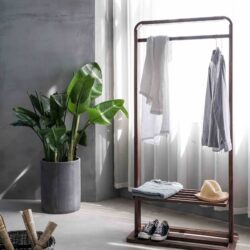Nordic Elegance: Scandinavian Kitchen Design with Natural Materials
Introduction: Step into the heart of Scandinavia, where simplicity, functionality, and a deep connection to nature converge to create the timeless charm of Scandinavian design. In the realm of kitchens, this style is characterized by clean lines, a neutral color palette, and a harmonious blend of natural materials. Join us as we explore the beauty of Scandinavian kitchen design, where the use of natural elements transforms the heart of your home into a space that is not only functional but also a celebration of the surrounding environment.
- Light and Airy Atmosphere: At the core of Scandinavian design is the desire to maximize natural light. Keep your kitchen bright and airy by opting for light-colored walls and cabinets. White or light gray tones create a canvas that allows natural materials to shine.
- Wooden Flooring: Infuse warmth and authenticity into your Scandinavian kitchen with wooden flooring. Choose light-toned wood, such as oak or pine, to create a seamless connection with nature. Wooden floors add a sense of coziness to the space while maintaining a clean and modern aesthetic.
- Natural Stone Countertops: Select natural stone countertops to bring a touch of luxury and durability to your kitchen. Materials like granite or marble, in neutral tones, not only elevate the aesthetics but also provide a durable and functional surface for meal preparation.
- Open Shelving with Wooden Accents: Embrace the trend of open shelving by incorporating wooden shelves into your kitchen. Display your favorite kitchenware or decorative items on these shelves, adding a touch of rustic charm while maintaining the Scandinavian commitment to simplicity.
- Exposed Wooden Beams: If your kitchen allows, expose wooden ceiling beams to amplify the rustic charm. This architectural feature not only adds character but also serves as a reminder of the natural elements that inspire Scandinavian design.
- Natural Fiber Textiles: Introduce natural fibers through textiles like cotton or linen. Choose neutral-toned tea towels, tablecloths, or curtains to soften the space and bring an element of comfort to your Scandinavian kitchen.
- Wooden Cabinets: Opt for wooden cabinets to further enhance the connection with nature. Light-colored or natural wood finishes create a warm and inviting atmosphere while maintaining the clean lines characteristic of Scandinavian design.
- Ceramic and Earthenware: Incorporate ceramic and earthenware dishes and accessories into your kitchen. These natural materials add texture and a handmade feel, aligning perfectly with the Scandinavian emphasis on craftsmanship and simplicity.
- Herbs and Potted Plants: Bring the outdoors in by incorporating potted herbs or plants into your kitchen. Not only do they add a burst of fresh greenery, but they also contribute to the Scandinavian ethos of living in harmony with nature.
- Sleek Metal Accents: Balance the warmth of natural materials with sleek metal accents. Stainless steel or matte black fixtures, such as faucets or cabinet handles, introduce a modern touch while complementing the overall Scandinavian aesthetic.
Scandinavian kitchen design with natural materials is a celebration of simplicity, functionality, and the beauty of the natural world. By incorporating wooden elements, stone surfaces, and earthy textures, you can create a kitchen that not only exudes elegance but also fosters a connection to the tranquility of the Nordic landscapes. Embrace the timeless allure of Scandinavian design and transform your kitchen into a space that harmoniously blends with the serenity of the surrounding environment.
Certainly! Here’s a set of frequently asked questions (FAQ) related to Scandinavian kitchen design with natural materials:
Q1: What defines Scandinavian kitchen design? A1: Scandinavian kitchen design is characterized by simplicity, functionality, and a focus on natural light. It often features clean lines, neutral color palettes, and an emphasis on natural materials.
Q2: How can I incorporate natural materials into a Scandinavian kitchen? A2: Use materials such as wood, stone, and metal. Opt for wooden countertops, floors, or cabinets. Incorporate stone or concrete elements, and add metal accents through light fixtures or hardware for a harmonious blend of natural materials.
Q3: What colors are suitable for a Scandinavian kitchen with natural materials? A3: Scandinavian kitchens typically use a neutral color palette with white, light gray, and beige as primary colors. These colors help enhance the natural light in the space and create an airy atmosphere.
Q4: Can I mix different types of wood in a Scandinavian kitchen? A4: Yes, mixing different types of wood can add warmth and visual interest. Just ensure that the tones complement each other. For example, combining light and dark wood can create a balanced and harmonious look.
Q5: What types of countertops work well in a Scandinavian kitchen? A5: Natural stone, such as marble or granite, and wood countertops are popular choices. These materials add a tactile and organic feel to the kitchen while maintaining a clean and timeless aesthetic.
Q6: Are there specific cabinet designs for a Scandinavian kitchen? A6: Scandinavian kitchen cabinets often have clean lines, flat-panel doors, and a minimalist design. Opt for cabinets in light colors, such as white or light gray, to contribute to the bright and open feel of the space.
Q7: How can I enhance natural light in a Scandinavian kitchen? A7: Use light-colored window treatments or opt for sheer curtains to allow maximum natural light. Keep windows unobstructed and use reflective surfaces, like glossy tiles or metallic accents, to bounce light around the room.
Q8: What types of flooring are suitable for a Scandinavian kitchen with natural materials? A8: Hardwood flooring is a popular choice for Scandinavian kitchens. Light-colored or natural finishes contribute to the overall bright and airy aesthetic. Other options include stone or ceramic tiles in neutral tones.
Q9: Can I add pops of color to a Scandinavian kitchen with natural materials? A9: Yes, you can add subtle pops of color through accessories like dishware, small appliances, or even a vibrant rug. Stick to a restrained color palette to maintain the overall Scandinavian design principles.
Q10: How can I create a cozy atmosphere in a Scandinavian kitchen? A10: Add elements like textiles, such as woven rugs or curtains, and consider incorporating a cozy dining nook with comfortable seating. Introduce soft, natural textures through cushions or throws to create a warm and inviting space within the kitchen.
In conclusion, the Scandinavian kitchen design with a focus on natural materials encapsulates a harmonious blend of functionality, simplicity, and the beauty of the natural world. This design ethos reflects the core principles of Scandinavian aesthetics, where clean lines, a neutral color palette, and the use of organic materials converge to create inviting and timeless kitchen spaces.
The prevalence of natural materials, such as wood, stone, and metal, is a hallmark of Scandinavian kitchen design. Wood, in particular, often takes center stage, contributing warmth and a connection to nature. Whether it’s showcased in light-toned wooden cabinetry, open shelving, or butcher block countertops, the use of wood imparts a sense of coziness and authenticity to the kitchen environment.
The color palette in Scandinavian kitchens leans towards neutral hues, with whites, grays, and soft earthy tones dominating the space. This subdued color scheme not only enhances the perception of natural light but also provides a canvas for the textures and grains of natural materials to shine. The result is a kitchen that feels airy, uncluttered, and effortlessly elegant.
Functionality is a key consideration in Scandinavian kitchen design, and the use of natural materials seamlessly aligns with this principle. Durable stone countertops, such as granite or marble, not only add a touch of luxury but also stand up to the rigors of daily use. Metal accents, whether in the form of stainless steel appliances or copper lighting fixtures, contribute to the functional and utilitarian aspect of the design.
Beyond aesthetics, the incorporation of natural materials in Scandinavian kitchens extends to sustainability. Many of these materials are renewable, recyclable, or sourced in an environmentally responsible manner, aligning with the region’s commitment to eco-conscious living. This eco-friendly approach adds an additional layer of appeal for those who value sustainability in their lifestyle choices.
Scandinavian kitchen design also embraces an open and uncluttered layout, allowing natural materials to take center stage without unnecessary ornamentation. The emphasis on simplicity and minimalism creates a serene and inviting atmosphere, making the kitchen not only a practical workspace but also a place for relaxation and socializing.
In conclusion, the Scandinavian kitchen design with its emphasis on natural materials is a celebration of simplicity, functionality, and a deep connection to the natural world. It transforms the kitchen into a space that is not only aesthetically pleasing but also conducive to a sense of well-being. By seamlessly integrating natural materials into the design, Scandinavian kitchens offer a timeless and inviting environment where form meets function in perfect harmony.
















